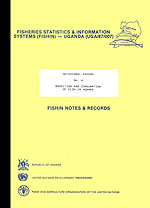
No. 4
MARKETING AND CONSUMPTION OF FISH IN UGANDA
| Fisheries Statistics and Information Systems (FISHIN) | UGA/87/007 OP No. 4 |
FAO/UNDP PROJECT UGA/87/007
FISHIN NOTES AND RECORDS
 | OCCASIONAL PAPERS No. 4 MARKETING AND CONSUMPTION OF FISH IN UGANDA |
| TABLE OF CONENTS |
By
C.T. Kirema-Mukasa1 & J.E. Reynolds2
| FISHIN - UGA/87/007 | June 1991 |
1 Fisheries Officer (Marketing), Uganda Fisheries Dept. (Equal Co-Author).
2 Socio-Economic Advisor, FISHIN Project, UGA/87/007. (Equal Co-Author).
ABSTRACT This study was originally prepared at the request of Project GCP/INT/467/NOR, “Increasing the Role of Fish in the Alleviation of Malnutrition”, Fish Utilization and Marketing Service, Fishery Industry Division, Fisheries Department, Food and Agriculture Organization of the United Nations. After a review of the basic country setting discussion ranges over a number of topics pertaining to patterns of fish marketing and consumption, including constraints to demand and supply which are hindering the national fisheries from serving a fuller role in fostering nutritional and economic welfare. Several proposals for development action are offered as a conclusion to the study. |
EDITORIAL NOTE FISHIN Occasional Papers are issued from time to time primarily as records of contributions made by Project personnel to regional and international fisheries-related workshops, seminars, symposia, studies, etc. Observations and findings presented in the papers are those of the authors and should be treated as preliminary and subject to further verification. Correspondence, comments, and suggestions are welcome and may be forwarded to: John-Eric Reynolds, Socio-Economic Advisor, FISHIN Project, UGA/87/007, FAO/UN, P.O. Box 521, Kampala, Uganda. |
Hyperlinks to non-FAO Internet sites do not imply any official endorsement of or responsibility for the opinions, ideas, data or products presented at these locations, or guarantee the validity of the information provided. The sole purpose of links to non-FAO sites is to indicate further information available on related topics.
This electronic document has been scanned using optical character recognition (OCR) software. FAO declines all responsibility for any discrepancies that may exist between the present document and its original printed version.
MARKETING AND CONSUMPTION OF FISH IN UGANDA
1. INTRODUCTION AND BACKGROUND
1.1 Physical Features, Population, and Food Production
1.4 Food Consumption Characteristics and Malnutrition
2. THE PATTERN OF FISH MARKETING
2.1 Marketing Stages and Channels
2.1.1 Producer-consumer linkages
2.1.2 Recent changes in marketing patterns
2.3 Trader Functions and Characteristics
2.3.1 Small-scale trader functions
2.3.2 Small-scale trader characteristics
2.3.3 Large-scale trading concerns
2.4 Equipment and Installations Used for Fish Marketing
2.5 Prices, Marketing Costs and Margins
2.5.1 Fresh and processed fish prices
2.5.2 Marketing costs and margins
2.6 Efficiency and Shortcomings in Fish Marketing Operations
3. THE PATTERN OF FISH CONSUMPTION
3.1 The “Typical/Frequent” Fish Consumer
3.2 Characteristics of Non-Fish Consumers
3.3 Competing Animal Protein Products
3.4 Consumer Attitudes and Preferences: Fish Consumption Habits
3.6 Consumer Education and Demand Promotion Activities
4. DEMAND AND SUPPLY CONSTRAINTS AND THEIR RESOLUTION
4.2.1 Constraints at the harvest and post-harvest production level
4.2.2 Constraints at the distribution level
5. PROPOSALS FOR DEVELOPMENT ACTION
5.1 National Fisheries Policy and Planning
5.2 Improved Monitoring and Reporting
5.3 Fisheries Production Restoration and Development
5.3.1 Restoration of Lake Wamala fisheries
5.3.2 Restoration of small-scale fish farming
5.3.3 Development of enhanced production systems
5.3.4 Development of the Lake Victoria Rastrineobola fishery and utilisation of other small-sized fishes
5.4 Integrated Development of the Fisheries Post-Harvest Sector
5.4.1 Transportation infrastructure
5.4.2 Landing sites, markets, and the organisation of trade
5.4.3 UFD Fish Technology Division
5.4.4 Integrated development of the post-harvest sector: a pilot scheme